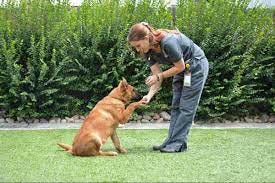Best Dog Training E-Book

Training dogs and cats involves different approaches due to their distinct behaviors and characteristics. Here are some general tips for training both dogs and cats:
Dog Training:
- Positive Reinforcement:
- Dogs respond well to positive reinforcement. Use treats, praise, and affection to reward good behavior.
- Ignore or redirect unwanted behavior rather than punishing.
- Consistency is Key:
- Be consistent with commands and rules. Dogs learn best when they can predict the outcome of their actions.
- Use the same cues and gestures for specific commands.
- Basic Commands:
- Teach basic commands like sit, stay, come, and lie down. These commands establish your role as the leader.
- Socialization:
- Socialize your dog with other animals, people, and different environments from an early age.
- Patience and Persistence:
- Training takes time. Be patient and persistent, and practice regularly in short sessions.
- Leash Training:
- Teach loose-leash walking to make walks enjoyable for both you and your dog.
- Problem Solving:
- Address behavioral issues promptly. Consult a professional trainer if needed.
Cat Training:
- Positive Reinforcement:
- Use treats, praise, and play to reward desired behaviors in cats.
- Avoid punishment, as cats may become fearful or stressed.
- Litter Box Training:
- Provide a clean litter box and place it in a quiet, accessible location.
- Scoop the litter regularly and clean the box to encourage use.
- Scratching Behavior:
- Offer scratching posts and pads to satisfy their natural instinct to scratch.
- Use deterrents on furniture and reward them for using appropriate scratching surfaces.
- Clicker Training:
- Clicker training can be effective for teaching cats tricks and commands.
- Interactive Play:
- Engage in interactive play with toys to keep your cat mentally and physically stimulated.
- Respect Their Independence:
- Cats are independent creatures. Respect their space and allow them to initiate interactions.
- Create a Safe Environment:
- Create a safe and stimulating environment to prevent boredom and reduce the likelihood of destructive behavior.
General Tips for Both:
- Start Early:
- Begin training as early as possible for both dogs and cats.
- Use Clear Commands:
- Use clear, consistent commands for both species.
- Short Sessions:
- Keep training sessions short and fun to maintain interest.
- Regular Exercise:
- Ensure regular exercise to keep them physically and mentally healthy.
- Vet Check:
- Regular veterinary check-ups are essential for both dogs and cats.
- Be Patient and Positive:
- Patience and positivity are crucial for successful training.
Remember that every pet is unique, so adjust your training methods to suit their individual needs and preferences. If you encounter challenges, consider seeking guidance from professional trainers or behaviorists.
Comments
Post a Comment